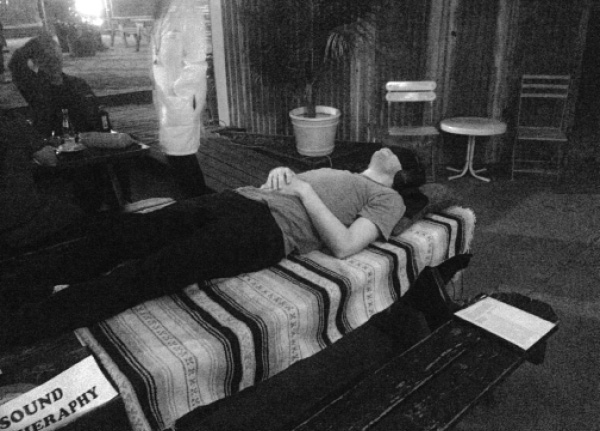
SOUND THERAPY
first performed on April 25, 2017
The Volstead, Austin, TX
performed once in 2017
BREKEKEKEXKOAXKOAX
(JOSH RONSEN / CHRISTINE DARLING)
Austin, TX
368631543j368631543o368631543s368631543h368631543@368631543r368631543o368631543n368631543s368631543e368631543n368631543.368631543o368631543r368631543g
ronsen.org
SOUND THERAPY
BREKEKEKEXKOAXKOAX
“Sound Therapy” neatly combined numerous aspects of my work that otherwise exist separately, including blindfolding, a direct contact between performer and audience, a serious absurdity, unusual presentation of sound and use of an extensive, personal archive of cat recordings. Taking place outside the performances held to celebrate the release of the Phonography Austin’s first compilation CD of field recordings, “Sound Therapy” was designed primarily as an alternative way to present recordings that are not meant to be musical (although they can certainly be presented and listened to as such). The problem of modern audience’s distraction and wandering attention was also addressed.
Christine and I, dressed in lab coats, approached people in the Volstead lounge and asked if they would like to undergo a session of sound therapy. After signing a standard waiver (“I, the undersigned, do hereby release the operators of Sound Therapy from liability from any intended or unintended effects of Sound Therapy, including but not limited to relaxation, waking dreamstates, panic, euphoria, night tremors, sympathetic purring, blushing, deep yawns, unwanted thought syndrome, noisy fingernails, eczema, bi-curiosity, bedhead, Alan Parsons Project, that feeling you get when you think you have to go to the bathroom but not right now but you don’t know when is the next time you’ll have a chance to go so you can’t stop thinking about it, or any other similar or dissimilar consequence”) they were blindfolded and made to lay on a table.
With headphones placed on their ears, each person heard… what? A deep rumbling. Some could discern the sound of a purring cat. People could listen for as long as they liked, and given that such a presentation could easily be seen as a joke, people listened to the purr for far longer than I expected. Post-session interviews revealed that afterwards people felt more relaxed, as if they were meditating and joining into the rhythm of the purr. Only one person described any negative effects, a feeling of anxiousness attributed to the sound as there is a struggle to provide privacy for the listener, against the urge to present the process as a spectacle.
Although a success by experimental music standards, “Sound Therapy” was only performed once. Future performances, perhaps using noise-canceling headphones, are possible.